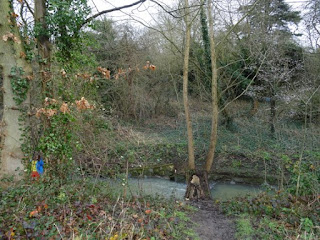Over the Fields by guest blogger Lucy Furlong
Four generations of my family have played and spent time walking ‘Over the Fields’, as we refer to the stretch of land along the Hogsmill. My paternal grandparents moved to Tolworth from Wexford, Ireland, in the 1940s, and these fields, back then much more substantive and less developed, and in some places still farmed, were an important reminder of and connection to rural Home for them.
Two years ago I started a writing and walking project with my father and son accompanying me on regular walks, where we talked about my dad’s experiences of playing in this space as a child in the 1950s, and where my son has had a chance to experience and get to know the space himself. I documented the walks with photographs, and then began to write poems about some of my father’s memories, my own memories, and our new experiences of walking and spending time there.
 The poems, photos and research eventually took shape as a poetry map, which was published last September and launched with an impromptu walk with friends and family ‘Over the Fields’, where the poems were read in the spaces that inspired them.Since then we have continued to go for walks, although not as often over the winter months, and I have spoken about the map and read some of the poems at various events, which has been great fun.
The poems, photos and research eventually took shape as a poetry map, which was published last September and launched with an impromptu walk with friends and family ‘Over the Fields’, where the poems were read in the spaces that inspired them.Since then we have continued to go for walks, although not as often over the winter months, and I have spoken about the map and read some of the poems at various events, which has been great fun.
Yesterday we went for a walk
in the local greenbelt close to where I live. This is the Hogsmill
Valley and Hogsmill Open Space, greenbelt land bisected by the Hogsmill
River, on the boundaries of Tolworth, Malden Manor and Old Malden.
 |
| 6 Acre Meadow |
We cross the river and turn right, noticing the rows of brown thistle
 |
| Small teasel Dipsa pilosus |
I take photos of the burgeoning blackthorn blossom; we walk under the railway bridge, Sam spots some new graffiti: “Granddad, look! It says “Poo”!” This becomes a theme as we continue along past ivy and lichen covered trees; my father complains about the ever-present bags of dog mess carefully tied onto or slung into and hanging from the branches of trees. They are an unpleasant and sadly growing feature of our walks, and I wonder what might help dissuade people from doing this?
 |
Sam finds his way down to the riverside. It is narrower, and the water is deeper and faster here. He wanders about and then tries to edge his way back before the inevitable shouting of: “I’m stuck!” can be heard through the trees. I look at the scene and see the Autumn- brown crackly oak leaves to the left, still on the tree, and opposite, on the other bank on the right hand side, a blossoming blackthorn. The tension between the seasons seems encapsulated here as the water rushes by: what was and what is, and what will be, and in the middle of it the water, all bathed in the pale sunshine of the last day of January.
Short Biography:
Lucy Furlong’s map, Over the Fields, was published in September and is available from http://www.lucyfurlong.com
A new piece of work about Over the Fields will be on display as part of the photographer Bill Mudge’s exhibition of his project 20 in 15, at the Mine gallery in Carshalton Village from March 5th – 27th http://www.mineonline.co.uk/
Lucy’s writing has been widely published, and she performs her poetry nationally. Her first poetry map, Amniotic City, was featured in The Guardian. A collection of her poems, clew, was published by Hesterglock Press in 2015. She teaches and lives in Tolworth.

Comments
Post a Comment
Please share your thoughts